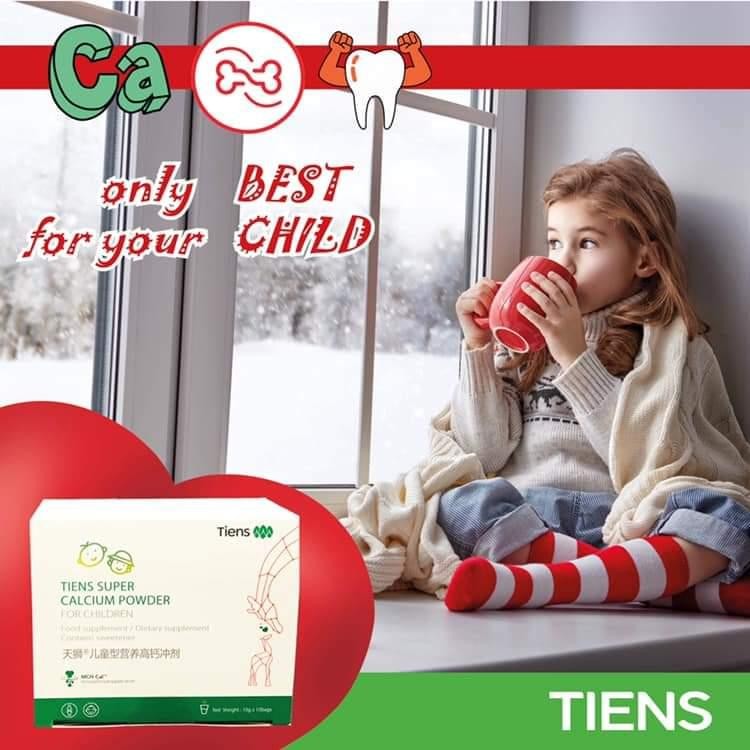

Calcium Powder for Children, 10g (10 bags)
It is worth noting that an appropriate calcium intake in childhood and adolescence pays off in the future since the so-called peak bone mass is reached around the age of 30. Calcium ensures strong bones, lowering the risk for bone fracture or minor damage. Moreover, childhood is the period when our teeth are formed.
Calcium requirement in children depends on age. The diet of children between 1 and 3 years of age should contain 500 mg of calcium per day. Children between 3 and 8 years should consume 800 mg per day, and older children and adolescents (9-18 years) as much as 1,300 mg (the norm for an adult is 1,000 mg).
The increased calcium requirement in children is a result of their active growth. Even a calcium-rich diet (dairy products, fish, legumes) does not always ensure appropriate levels of calcium. For example, a glass of milk corresponds to 60 % of calcium requirement of a young child whereas that number is merely 20 % for a teenager.
Calcium deficiencies – hypocalcaemia leads to many disorders in the body, osteoporosis and tetany, whose signs include a tingling sensation in the fingertips and around the mouth. Later symptoms include limb muscle cramping.

The ingredients contained in the preparation:
-
- Calcium contributes to normal muscle function, neurotransmission, maintenance of normal bones and teeth.
- Phosphorus contributes to the maintenance of normal bones and teeth.
- Vitamin C contributes to normal collagen formation for the normal function of bones, cartilage, gums, teeth, functioning of the nervous system, protection of cells from oxidative stress.
- Vitamin D contributes to normal absorption/utilisation of calcium and phosphorus, maintenance of normal bones, muscle function, normal teeth, function of the immune system.
- Vitamin A contributes to the normal function of the immune system and has a role in the process of cell specialisation.
- Zinc contributes to normal metabolism of vitamin A, contributes to the maintenance of normal bones, function of the immune system and protection of cells from oxidative stress.
ACTION
The components of the preparation exhibit a broad spectrum of activity:
- calcium covers 45% of the daily requirement for this element in children and adolescents.
- calcium and vitamin D help sustain proper calcium levels in the body, which relates to strengthening of the bones, preventing osteoporosis and has a beneficial effect on the condition of teeth,
- calcium relieves allergy symptoms,
- calcium supports the nervous system,
- vitamin D boosts the natural defense mechanisms of the body,
- vitamin D facilitates calcium and phosphorus assimilation,
- vitamin D has a positive effect on muscle development in children,
- vitamin D and zinc has a positive impact on the condition of the skin in children, help relieve skin inflammations,
- zinc relieves the symptoms of acne,
- lecithin supports memory and concentration
DOSING
Children between 1 and 3 years of age – dissolve ½ sachet in ½ glass of warm water, once a day in the evening. Children above 3 years of age – dissolve 1 sachet in ½ glass of warm water, once a day in the evening.
RECOMMENDATIONS
The preparation can be administered to children as a preventive measure twice a year as a 28-day treatment, in spring and autumn.
Recommended for administration to children during active growth and teething, in periods of high demand for calcium.
NOTE
Any vitamin and micro-element supplementation in children should be consulted with a doctor.
The preparation is not to be administered to children below the age of 1.
Not suitable for children with milk intolerance and digestive system disorders.
Usually bought with

Fast shipping

Hassle-free returns

Secure shopping

Money-back guarantee
Sign up to our mailing list for 10% off your order

 An item was added to cart!
An item was added to cart!





